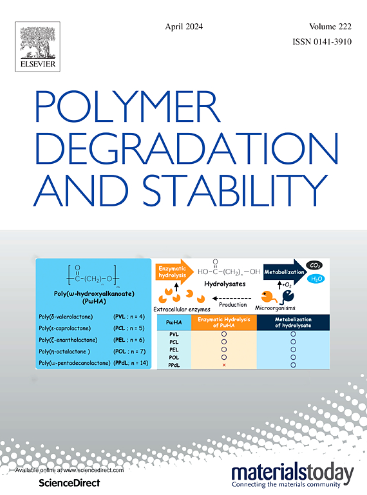聚酯-酰亚胺薄膜的原子氧侵蚀
IF 6.3
2区 化学
Q1 POLYMER SCIENCE
引用次数: 0
摘要
本文章由计算机程序翻译,如有差异,请以英文原文为准。
Atomic oxygen erosion of a poly(ester-imide) film
Poly(ester-imide)s (PEIs) are considered the most promising polymers for space exploration attributed to their flexibility, low-density, and outstanding mechanical behaviors. Nevertheless, their atomic oxygen (AO) degradation effects pose a significant challenge for PEI films deployed in low Earth orbit (LEO). In this study, we examined the structural evolution behaviors and AO degradation mechanisms of the PEI by integrating exposure tests with reactive molecular dynamics (ReaxFF-MD) simulation. The PEI exhibited linear AO erosion kinetics, characterized by a constant erosion yield (Ey) of ∼1.1 × 10−24 cm3 atom−1. Morphological analysis revealed the ascending surface roughnesses and shaggy topographies as AO fluence increased. Spectroscopic investigations demonstrated that the extensive elimination of specific sites (C=O, C-O-C, C-N, C-H, and C-C groups) and the release of volatile species (H2O, COx, and NOx) were the priority consequences of AO erosion. In addition, the AO-exposed PEI demonstrated the gradual declines in hydrophobicity and transparency. Moreover, the ReaxFF-MD simulation aligned with the experimental results, further corroborating the rationality of the collision enhanced erosion reaction mechanism.
求助全文
通过发布文献求助,成功后即可免费获取论文全文。
去求助
来源期刊

Polymer Degradation and Stability
化学-高分子科学
CiteScore
10.10
自引率
10.20%
发文量
325
审稿时长
23 days
期刊介绍:
Polymer Degradation and Stability deals with the degradation reactions and their control which are a major preoccupation of practitioners of the many and diverse aspects of modern polymer technology.
Deteriorative reactions occur during processing, when polymers are subjected to heat, oxygen and mechanical stress, and during the useful life of the materials when oxygen and sunlight are the most important degradative agencies. In more specialised applications, degradation may be induced by high energy radiation, ozone, atmospheric pollutants, mechanical stress, biological action, hydrolysis and many other influences. The mechanisms of these reactions and stabilisation processes must be understood if the technology and application of polymers are to continue to advance. The reporting of investigations of this kind is therefore a major function of this journal.
However there are also new developments in polymer technology in which degradation processes find positive applications. For example, photodegradable plastics are now available, the recycling of polymeric products will become increasingly important, degradation and combustion studies are involved in the definition of the fire hazards which are associated with polymeric materials and the microelectronics industry is vitally dependent upon polymer degradation in the manufacture of its circuitry. Polymer properties may also be improved by processes like curing and grafting, the chemistry of which can be closely related to that which causes physical deterioration in other circumstances.
 求助内容:
求助内容: 应助结果提醒方式:
应助结果提醒方式:


